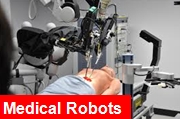 Medical robots cover a broad range of medical devices, from surgical assistants to exoskeletons and companion or assistive robots. These new devices are involved in all aspects of healthcare, including therapy, rehabilitation and patient monitoring. Robotics has the potential to improve risk-benefit ratios, speed up recovery times and reduce the overall cost of healthcare.
Medical robots cover a broad range of medical devices, from surgical assistants to exoskeletons and companion or assistive robots. These new devices are involved in all aspects of healthcare, including therapy, rehabilitation and patient monitoring. Robotics has the potential to improve risk-benefit ratios, speed up recovery times and reduce the overall cost of healthcare.
Improved risk-benefit ratios
The increased use of robot-assisted surgery is a matter of controversy in the medical community. Some research shows better patient results while other research shows no difference between surgeries. Robot-assisted surgery has been touted as an excellent tool for less experienced surgeons but has also been criticized as being prohibitively expensive. However, the expense is apparently due to a lack of competition, which is likely to change in the near future as more medical device companies devote themselves to manufacturing robotics.
Faster recovery times
Rehabilitation therapy is lengthy and repetitive as well as expensive. Repetitive motions which are necessary for increasing muscular strength, improving coordination and remapping the brain depends on the availability and physical strength of the rehabilitation therapists. Rehabilitation robots are ideal for performing repetitive and physically difficult tasks and they can free up humans for other work while they speed up recovery times for patients.
Lower healthcare costs
Robotic Replacement for Diminished or Lost Function provide patients with mobility much quicker than any other method. Patients leave the hospital and rehab facilities faster, returning home and saving money for the healthcare system. Wearers of exoskeletons demonstrate improvements in cardiovascular health, loss of fat tissue, building of lean muscle mass, and improved bowel function, further reducing costs for their care. As the FDA is beginning to allow the marketing of prostheses and exoskeletons to the public, the market is predicted to grow by leaps and bounds in the coming years. A study by Global Industry Analysts predicts that the robotic replacement industry will grow to $23.5 billion by 2017, fueled by an aging population and increasing numbers of patients suffering from diabetes, strokes, arthritis and osteoporosis.
A new emerging market is that of personalized care for the elderly. This market is really in its infancy, but as the population ages, it is becoming prohibitively expensive to employ caregivers for all the elderly who require it. Interactive care robots remind patients to take care their medication, provide speech therapy and physical exercise, facilitate communication with family members and alert medical staff in case of an emergency.
The Affordable Healthcare Act and robotics
It is as yet unclear how the Affordable Healthcare Act will affect the robotics industry and how the robotics industry will affect Obamacare. Currently, hospitals are reimbursed at the same rate for a procedure whether there is a robot involved or not. This means that they will use a robot only if it saves time and allows the hospital to perform more procedures. There has already been a move away from early-stage investment in favor of late-stage investment in more proven technology. Developers and manufacturers will have to emphasize affordable price points in order to attract investors and obtain Medicaid approval.
At Triode, we have worked with Titan Medical on developping a surgical system focusing on minimally invasive surgery and Kinova an assitive robotics company based in Montreal, Canada. Both companies intent to improve the healthcare system with the use of robots.
Patrick Sirois
psirois@triode.ca
At Triode, we specialize in developing new products and services for complex industries like medical devices and transportation. We work with you closely to help define product strategy, with an emphasis on reducing the risks associated with innovating in these sophisticated and often regulated consumer-oriented environments.
